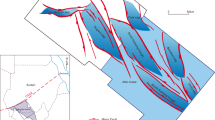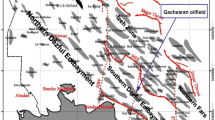Abstract
This paper investigates the sedimentary characteristics, geochemical indicators of source rock, and the hydrocarbon potential in detail within the Paleogene and Upper Cretaceous in the northern Kaikang trough, Muglad Basin. Analysis shows that the thickness of good source rocks in Paleogene ranges from 50 to 200 m, and the TOC value can reach 0.5–1.3%, but it is immature and has no hydrocarbon generation potential. Nevertheless, the Upper Cretaceous source rocks had mostly entered the maturity threshold, with a TOC value of only 0.5–0.8%, and a thickness of only 10 m, so the hydrocarbon generation is limited. The main effective source rock is the AG Group in the Lower Cretaceous, which is distributed throughout the area. The evolutionary history shows that most of the structures in the central troughs lack hydrocarbon potential, because they were formed since the Paleogene, which is later than the main accumulation period of the AG source rock. Petroleum discovery was made in the fault terrace zones on both sides of the Kaikang Trough, but the distribution of oil layers is very complicated. Hydrocarbon accumulation is controlled by formation dips, fault activity intensity and fault lateral docking characteristics. The weaker active fault block in late time and the more effective trap are the key to hydrocarbon enrichment at the fault terrace-zones.
Access provided by Autonomous University of Puebla. Download conference paper PDF
Similar content being viewed by others
Keywords
1 Introduction
The Kaikang Trough is located in the middle of the Muglad Basin and can be divided into the north and the south sub-depressions. The area of the north sub-depression is approximately 7000 km2. After intensive hydrocarbon exploration, only a few reservoirs have been discovered within the Upper Cretaceous and Paleogene. It is unclear whether the Upper Cretaceous and Paleogene in the Kaikang Trough are capable of hydrocarbon generation, or secondary reservoirs can be formed.
2 Methods
In view of above geological problems, the authors have investigated the stratigraphic characteristics of sediments, hydrocarbon generation potential of source rocks, and the main controlling factors of hydrocarbon accumulation, in detail, within the Paleogene and Upper Cretaceous of the area.
The log data and core data of 8 wells in the area were analyzed, and the characteristics of the sedimentary facies were studied. Well logging method was utilized to calculate the TOC value of the source rock in every well, due to the lack of core geochemistry analysis in this area. By restoring the history of regional tectonic evolution, the formation period of the tectonic structure in the trough, and its relationship with the hydrocarbon generation history of the source rocks are inferred. The reservoir types and their structural features as well as failed wells are analyzed, to study the main controlling factors of reservoirs and the next exploration direction. Key issues that need attention are proposed.
3 Results
3.1 Sedimentary Facies Characteristics
Based on logging curves and sedimentary combination analysis, the Upper Cretaceous and the Paleogene of the Kaikang Trough were dominantly developed in river-flooding plain, delta and shore-shallow lacustrine facies. The river-flooding plain facies were mainly developed in the Paleogene Amal-Nayil Formation. They are mainly composed of sandstone, red and green mudstones, with upward-fining intervals in lithology, and an erosional base. These sedimentary features show meandering river deposits. The Upper Cretaceous strata of Zarqa, Gazal and Baraka Formations are mainly composed of deltaic sediments, and the deltaic plains contain sandstone, green and red mudstones. The delta fronts are composed of sandstone and gray mudstone, with upward-coarsening intervals. Aradeiba Formation in the lower part of the Upper Cretaceous comprises delta-front and shallow lake deposits, consisting of grey muddy sandstone and siltstone.
3.2 Characteristics of Source Rocks
The main proven source rock in the Muglad Basin is the AG Group in the Lower Cretaceous, which is distributed throughout the area, where a large number of oil reservoirs have been discovered. The existence of source rocks in Upper Cretaceous and Paleogene, in this area, has not yet been confirmed. In this study, the most widely used TOC evaluation methods for well log curves are used to calculate the TOC values for eights representative wells in the study area. The results show that the effective source rocks of Paleogene are mainly distributed in the central and northern regions, which are close to the distribution of the sedimentary center of the Kaikang Trough. The thickness of the Paleogene source rock ranges from 50 to 200 m, and the TOC content can reach 1–4%, which indicates a high quality source rock.
The distribution of source rocks in the Upper Cretaceous is similar to the Paleogene, but the thickness is relatively thin, about 10–25 m. In addition, the TOC content of the Upper Cretaceous source rocks is only 0.5–0.8%, which is a moderate-quality source rock, with a limited hydrocarbon generation potential. The history of thermal evolution in this area indicates that the burial depth of 1800 m corresponds to 0.6% of Ro, so this depth is the threshold of effective source rock in this area. However, the burial depth of the Paleogene source rock with a TOC of 1–4% is mostly 1500 m or less, and it is immature. Nevertheless, the Upper Cretaceous source rock mostly entered the maturity threshold, its TOC value is only 0.5–0.8%, and its thickness is about 10 m, so the hydrocarbon generation potential is limited (see Fig. 1).
The thermal evolution simulations of AG group indicate that it entered the peak of oil production during the deposition time of Aradeiba-Baraka Formations, and entered the gasification window in the period of Amal sedimentary time, which has now reached a high state of maturation.
3.3 Hydrocarbon Accumulation Characteristics
Since the wells in the central Kaikang Trough were drilled before the 1990s, the data and information were incomplete. The reinterpretation of the reservoirs and hydrocarbons for 5 wells showed that the reservoir of Paleogene and Upper Cretaceous is well developed, with an average porosity of 10–18%, and a thickness of up to 50–200 m. However, there is no hydrocarbon display during drilling and logging, so all these wells are interpreted as dry wells. The analysis of the evolutionary history of the central Kaikang Trough shows that most of the structures in the central troughs were formed since the Paleogene, which is later than the main accumulation period of the AG hydrocarbon source. These structures lacked oil filling, so the hydrocarbon potential is limited.
The reinterpretation of the four wells in the stepped zone, on both sides of the Kaikang Trough, shows that the Cretaceous and Paleogene reservoirs were well developed, with an average porosity of 7–12%, and a thickness up to 10–30 m. Several oil layers were discovered in two wells, and heavy oil was obtained from one of the tested wells, which indicates that the hydrocarbon potential of the fault terrace zones is better than that in the center of the trough. However, due to the complicated structures of the fault terrace zones and the fault contact relationship, the distribution of petroleum layers is very complicated.
4 Discussion
Based on the analysis of the reservoirs, and of the oil and gas wells found in the Kaikang Trough, the main controls of hydrocarbon accumulation are formation dips, fault distance and fault lateral docking characteristics. Firstly, the reservoirs with good hydrocarbon accumulations often have a lower structural dip, mostly less than 3°. Secondly, most of the oil reservoirs have a fault distance less than 200 m, and there are hardly any hydrocarbon accumulations in reservoirs which have a fault distance greater than 200 m, especially greater than 500 m. The third factor is the formation lithology on both sides of the fault. Sandstone and mudstone connection can seal the reservoir, but sandstone and sandstone docking can invalidate the trap. Therefore, the weaker active fault block in late time and the more effective trap are the key to hydrocarbon enrichment at the fault terrace zones in the faulted depression.
5 Conclusions
This paper shows us that the source rocks in the Upper Cretaceous and the Paleogene have limited hydrocarbon generation potential, and the main effective source rock is the AG Group in the Lower Cretaceous. The hydrocarbon potential of the Paleogene in the northern Kaikang Trough is poor, because the structures in the central troughs were formed since the Paleogene, which is later than the main accumulation period of the AG hydrocarbon source. The main controls of hydrocarbon accumulation in the Kaikang Trough are formation dips, fault distance and fault lateral docking characteristics. The eastern stepped zone developed many fault blocks with a small dip angle, which is beneficial to the large-scale lateral migration of hydrocarbon from the AG source rock. So, those are the favorable areas for oil exploration.
Author information
Authors and Affiliations
Corresponding author
Editor information
Editors and Affiliations
Rights and permissions
Copyright information
© 2019 Springer Nature Switzerland AG
About this paper
Cite this paper
Bian, C., Feng, Y., Li, J., Zhou, X., Li, Y., Zhang, X. (2019). Source Rocks and Hydrocarbon Accumulation Characteristics of Upper Cretaceous to Paleogene in the Northern Kaikang Trough, Muglad Basin, Sudan. In: Banerjee, S., Barati, R., Patil, S. (eds) Advances in Petroleum Engineering and Petroleum Geochemistry. CAJG 2018. Advances in Science, Technology & Innovation. Springer, Cham. https://doi.org/10.1007/978-3-030-01578-7_33
Download citation
DOI: https://doi.org/10.1007/978-3-030-01578-7_33
Published:
Publisher Name: Springer, Cham
Print ISBN: 978-3-030-01577-0
Online ISBN: 978-3-030-01578-7
eBook Packages: Earth and Environmental ScienceEarth and Environmental Science (R0)





